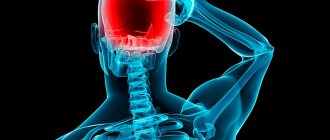A cluster of disorders affecting the neuropsychic sphere of a person and arising due to sudden or chronic mental trauma. In general, it is characterized by the absence of constructive changes in mental activity. In other words, this nervous disorder is a peculiar response of the body to stress, permanent experiences and internal conflict of the individual, which arise in the event of frustration, that is, a discrepancy between real possibilities and a person’s desires. Neurotic conditions are graded according to level and severity. They can be chronic or situational in nature. According to WHO, 400 million people experience some form of mental illness. Neuroses and neurotic conditions are considered the most common mental disorder.
Diagnosis of neuroses
According to clinical statistics, almost every person, one way or another, at a certain period of his life has encountered states of neurotic instability of varying degrees of severity. The easiest, primary stage of such conditions is defined as neurotic and represents a reaction of the psyche to certain external events: sudden grief, difficulties with adaptation, prolonged stress, and so on. It is these conditions that are also designated as borderline (non-psychotic) and lie in the field of study of minor psychiatry. A psychologist or neurologist can diagnose mild situational neurosis, as well as prescribe therapy, but if the situation becomes more protracted and complex, then the help of a psychiatrist is necessary.
Symptoms of neurotic disorders
Neurotic dysfunctions are characterized by instability of mood and rash actions. Patients suffer from memory impairment, problems with concentration, and a number of other clinical manifestations:
- causeless psychological stress;
- increased fatigue;
- sleep problems;
- isolation;
- fixation on problems in life;
- memory impairment;
- dizziness;
- fainting;
- migraine;
- pain in the heart muscle and joints;
- frequent urination;
- excessive sweating;
- decreased potency;
- high or low self-esteem;
- inconsistency, uncertainty;
- tearfulness;
- aggressiveness;
- suspiciousness;
- poor prioritization.
Symptoms of neurotic disorders are often complemented by increased sensitivity to light, sound, and reactions to minor temperature changes.
Signs of neurotic disorders
Signs of neurotic disorders vary by gender. In women, asthenic neurosis more often appears, characterized by aggressiveness, loss of mental and physical ability, and lack of sexual desire. During intimacy, it is impossible to relax. A woman suffering from asthenic neurosis quarrels with relatives and often loses her temper over trifles. Constant tension is fraught with the development of diseases of internal organs.
In men there are the following types:
- depressed – a person is not able to realize himself in the world of work, or adapt to sudden changes in any area of life;
- male neurasthenia - usually appears after physical or moral overstrain; workaholics are susceptible to this type.
Men and women over 45 years of age are prone to these types of diseases. They may still have problems with the functioning of their internal organs.
Neurotic disorder syndrome
The syndrome of neurotic disorders is a reflection of a traumatic circumstance and is often combined with other neurotic manifestations. The patient's mood decreases, but there is no feeling of melancholy. Usually, a bad mood is combined with emotional lability, asthenia, mild anxiety, loss of appetite and insomnia. During the day, no special fluctuations are observed, or they are mild. Mental and motor retardation, self-flagellation, and suicidal thoughts are not typical.
- Neurotic depression is distinguished from reactive depression, which is also caused by traumatic circumstances. In the second type, the symptoms reach the level of reactive psychosis - the patient is depressed, inhibited, consciousness is narrowed, and thoughts of suicide appear.
- In the case of psychotic depression, the patient wishes to die, there is gross disorientation of the personality with separation from life, sudden anosognosia, delusional ideas of self-humiliation, manic episodes. The condition can be controlled with antidepressants and a repeated course of treatment.
- Neurotic depression is characterized by the preservation of the basic personality qualities, the patient is aware of his condition. Obsessive phobias and pronounced hysterical manifestations appear.
Important! Psychotic depression is more dangerous for a person and requires immediate treatment.
Levels of neurotic disorders
Neurotic disorders occur at 3 levels: as a manifestation of individual symptoms, at the level of minor syndromes, and as specific disorders.
Levels of neurotic disorders.
- Individual symptoms. They are also present in those who do not suffer from mental disorders.
- A minor emotional disorder can be complemented by several neurotic syndromes, of which the leading one is not identified.
The patient population consists of 2 types:
- some suffer from an acute, short-term stress reaction;
- others experience long-term, chronic impairment.
Most patients recover within six months, while others recover in no less than 3 years.
Symptoms of neurosis
Most often, neurotic disorders are characterized by mixed clinical symptoms. The prevalence of certain characteristics is associated with the specific location of the lesion in the nervous system.
The general possible symptoms of neurotic disorders are quite multifaceted and can manifest themselves both at the somatic level (physiologically) and at the psychological or psychopathic level.
Symptoms of psychopathy include: sleep disturbances (insomnia), loss of appetite or overeating, various panic states (fears, nightmares, phobias, hypochondria) and so on. At the physiological level, the patient can experience a wide range of ailments: pain in different parts of the body (psychalgia), migraines (headaches), a feeling of numbness, coldness or sweating of the extremities, fainting, tachycardia, a feeling of a lump in the throat, a feeling of suffocation, frequent urination, diarrhea. Disturbances in the functioning of body systems without visible organic changes are defined as somatoform disorders.
Somatoform disorders are a group of diseases of a mental nature in which somatic symptoms mask the original neurotic nature of the disease. Thus, the patient has somatic complaints, but there are no pathological changes in the internal organs that could explain these complaints.
The causes of neuroses, as will be discussed in detail below, can be absolutely any traumatic situation that provokes sudden or chronic emotional exhaustion. The symptoms of the disease themselves are determined by the general background of predisposition: the situation in the family, the level of socialization and self-realization, genetic predisposition, and so on. However, the general history of the disease coincides in the following parameters.
Important symptoms of incipient neurosis:
- Hypersensitivity to stress . Violent emotional reaction to minor events: despair, anger, etc.
- Increased levels of anxiety.
- Total focus on the traumatic situation (obsession).
- Tearfulness.
- Excessive vulnerability and touchiness.
- Asthenia (fatigue syndrome) , fatigue, decreased concentration, absent-mindedness.
- Misophonia (sensitivity to loud sounds) , as well as bright light or sudden changes in temperature.
- Insomnia and other sleep disorders : inability to fall asleep, intermittent, shallow sleep, drowsiness during the day
- Autonomic disorders : pressure changes, rapid breathing, arrhythmia or tachycardia, sweating, diarrhea, nausea and others.
- Decreased libido and potency in certain cases.
If you experience two or more of the above conditions on a long-term basis, then you should not ignore them. You should listen to your body, seek help in time and take the necessary measures.
What is a neurotic disorder
What is a neurotic disorder? It is a heterogeneous group of dysfunctions that arise as a result of acute or chronic psychological trauma. Symptoms are varied, but maladaptation, phobias, asthenia, obsessions and somatovegetative disturbances are always noted. A person's physical and mental abilities are temporarily weakened. Self-awareness and criticism persist. The diagnosis is made based on complaints, medical history and the person’s life history. To eliminate the problem, they resort to psychotherapy and medication.
Neurotic disorder is characterized
Doctors mean by neuroses a group of pathologies that arise due to the influence of mental trauma. A neurotic disorder is characterized by a deterioration in well-being, mood swings are noted, and somato-vegetative symptoms appear. In severe cases, suicidal thoughts are possible.
Forms and types of neuroses
In a general clinic, based on symptoms, neuroses are divided into two groups: physical and mental. At the physical (physiological) level, a neurotic disorder manifests itself specifically in the human body and can affect any system of the body: muscular (facial neurosis, neuralgia), respiratory (choking attacks), cardiovascular (tachycardia), pharyngeal neurosis, gastrointestinal (diarrhea) and other species.
As for neuroses of a mental nature, emotional reactions are affected. Mental neuroses are divided into 4 subtypes:
Depressive neurosis
Usually manifests itself in a bad mood, a decrease in intellectual function and volitional resource, and an inability to concentrate. From a physical point of view, it is characterized by a lack of appetite or, conversely, overeating, often a decrease in sexual activity.
Hypochondriacal or anxiety neurosis
Another name is neurosis of fear or obsessive states. Characteristic signs: excessive anxiety for minor or non-existent reasons, unreasonable fear, general depression, obsessive negative thoughts. Disturbances in the body are associated with disruption of the functioning of the autonomic nervous system, when a person begins to inadequately assess his health. For example, there is excessive fear for one’s physical condition and a tendency to attribute to oneself illnesses that do not exist. But the danger is that symptoms eventually begin to appear, although the disease itself is in fact absent.
The underlying conflict lies in the plane of contradictions between one’s own desires, needs and sense of duty.
Asthenic neurosis or neurasthenia
With this disorder, symptoms such as asthenia and psychasthenia come to the fore, namely fatigue, frequent mood swings, fixation on negative thoughts, lack of focus, difficulties with concentration and intellectual activity, abilities, insomnia and decreased libido, discomfort in the body ( pain, numbness, cramps, etc.). Usually arises as a result of frustration, that is, a long-term conflict (contradiction) between the real capabilities of the individual and his desires.
Hysterical neurosis
In certain cases it may be associated with narcissistic personality disorder. Among the key signs, it is worth noting inflated or changeable self-esteem, a constant high need for the attention of others, mannerisms, etc. In connection with the above, the motivating factor of hysteria is a neurotic conflict, characterized by unreasonably inflated demands of the patient on the environment without taking into account the moods and wishes of other people. Optionally, there may be an inability to empathize.
According to the duration and nature of the course, neurotic conditions can be situational and chronic. Situational neurosis is a reaction of the human nervous system to stress, the duration of which is related to the duration of the stress factor. Once the negative situation is over, self-healing occurs automatically. A more complex situation is chronic neurosis, a state in which the patient can remain throughout his life, which is due to general unconstructive patterns of response to the surrounding reality. For such a person, life itself and its details are the causes of constant stress. Why is this happening? What is a psychogenic factor?
Neurotic personality
Neurotic personality or character neurosis are psychoanalytic terms denoting a personality pathology that largely coincides with psychopathy. These are immature individuals who are characterized by at least three cardinal features: abnormal needs, complexes and psychological defenses. We would consider it worthwhile to describe them in the hope that this will lead to a better understanding of the experiences and behavior of patients with personality disorders, that is, psychopaths.
In our opinion, abnormal or neurotic needs are described most fully by K. Horney (1942). K. Horney presents such needs or tendencies as defensive strategies that are used by patients to overcome “basic anxiety” - a feeling of “loneliness and helplessness in the face of a potentially dangerous world.” These are initially normal, but have become “excessive” needs, which the neurotic personality uses inflexibly, choosing one in all social interactions. “If he needs love, he should get it from a friend, a doctor, an employer and a shoeshine boy,” explains K. Horney. These are the needs.
| | How to treat neuroses? |
- In love and approval there is an insatiable desire to be loved, an object of admiration and at the same time increased sensitivity to criticism, rejection, and manifestations of unfriendliness.
- In the leading partner - excessive dependence on others and the belief that love can solve everything.
- Clear restrictions include undemandingness, contentment with little, subordination to others.
- In power there is a tendency to dominate and despise the “weak”.
- In exploiting others, there is a fear of being used by others or of looking “dumb” in their eyes, but an unwillingness to do anything to outsmart them.
- In public recognition - the desire to be an object of admiration, the dependence of self-esteem on social status.
- In self-admiration, there is a desire to embellish the image of oneself, to present it as devoid of shortcomings and limitations.
- Ambition is a strong desire to be the best, regardless of the consequences; creates fear of failure.
- In self-sufficiency and independence - avoidance of any relationship that involves taking on obligations; distancing from everyone and everything.
- In impeccability and irrefutability - the desire to be perfect and infallible in everything; maintaining an impression of perfection and virtue.
- In descriptions of psychopathy there are references to many neurotic needs. It is curious, but K. Horney distinguishes only three types of neurotic character (compliant, detached and hostile), although, according to expectations, there could be more.
As for the complexes, their discovery is known to be associated with C. Jung. The complex, he believed, could behave as an independent personality, with its own mental life and movement, controlling a person and using his psyche for its own purposes. L.N. Tolstoy, thought K. Jung, was dominated by the idea of forgiveness, and Napoleon was dominated by the thirst for power. When identifying and measuring the strength of a complex, three methods can be used, according to C. Jung: direct observation (plus analytical deduction, for example, dream analysis), detection of indicators of the complex (for example, slips of the tongue) and measurement of the intensity of emotional expression (for example, pulse rate). Here is a short description of the most frequently mentioned complexes:
- The Antigone complex (named after the daughter of Oedipus, who voluntarily went into exile with her father) is manifested by the daughter’s unconscious sexual attraction to her father. It is believed to be the basis of some neuroses and perversions.
- The Griselda complex (named after the heroine of D. Boccaccio’s “The Decameron”, who became a model of female virtue) is the incestuous attraction of a father to his daughter, the desire to keep her for himself, refusing all suitors for her hand.
- The grandfather complex is a man’s desire to become his grandfather, in order to become superior to his father, to gain power over him. Believed to be associated with incestuous desires and gerontophilia.
- The Diana complex (named after the goddess who had masculine interests and was indifferent to the opposite sex) is a reluctance to be a woman, supposedly due to envy of boys’ penises. Considered as the cause of some perversions and neurotic states.
- The Jocasta complex (named after the mother who fell in love with her son, Oedipus) is the incestuous attraction of a mother to her son.
- The Cain complex (named after the biblical Cain, who killed his younger brother, Abel, out of envy) is the hatred of a child deprived of the love of his parents for his sibling(s), caressed by tenderness.
- The castration complex is the fantasy of children when a boy is afraid of losing his penis (his father castrates him out of jealousy), and a girl dreams of getting it.
- The Medea complex (named after the mythical princess who killed her children out of jealousy for her husband, Jason, and poisoned her rival) is the desire of a mother to kill her children in order to take revenge on her husband.
- An inferiority complex is an avoidance of difficulties in order to rid oneself of the awareness of one’s inadequacy.
- A superiority complex is an avoidance of supposedly “insignificant” difficulties, coupled with demonstrating one’s superiority in something else. It is also referred to as overcompensation.
- The Orestes complex (named after the mythical hero who took revenge on his mother for the murder of his father) is an unconscious desire to kill his mother.
- The Phaedra complex (named after the mythical queen who experienced a love passion for her stepson) is an incestuous attraction of a mother to her adopted or step-son.
- The Oedipus complex (named after the mythical hero who killed his father and married his mother) is the incestuous attraction of a son to his mother and jealousy and hatred of his father.
- The Electra complex (named after the mythical heroine who took revenge on her mother for her murder of her father) is a daughter’s hatred of her mother and sexual attraction to her father.
According to C. Jung, any emotionally significant idea or any desire can become a complex if they are suppressed or repressed from consciousness. The number of complexes, therefore, is far from limited to those mentioned here. The idea of complexes captures a number of behavioral deviations, the causes of which remain unknown. However, it is purely hypothetical. The number of complexes can be increased to a degree that discredits the very idea of their existence.
Finally, a neurotic personality is characterized by various forms of psychological defense - mental actions aimed at eliminating anxiety and feelings of danger. Psychological defenses are formed and function unconsciously. For a neurotic personality, they are ways of self-deception about oneself and real external situations. Here is a short description of the main defensive strategies.
1. Repression (motivated forgetting) - removal of traumatic ideas from consciousness. Usually persistent, beyond the control of conscious effort. Repressed material can reveal itself in different ways: dreams, slips of the tongue, involuntary actions, witticisms, somatic symptoms, childhood fears of adults, as well as symbolization, i.e. displacement to other objects: for example, a feeling of hostility towards the father is manifested by hostility towards other manifestations of authoritarianism.
2. Projection - attributing one's own unacceptable thoughts, feelings, intentions and actions to other people. In projection, the person says, “She hates me,” instead of “I hate her.” The projection is carried out in three stages. At the first stage, one denies oneself an unacceptable quality. On the second - externalization, i.e. transferring this quality to another person. At the third stage, conversion occurs, i.e., recognition of this quality in another person directed towards oneself. Thus, according to Freud, paranoid arises, which, as he believed, is a consequence of the projection of homosexual desire.
3. Substitution - the transfer of an instinctive feeling or impulse, such as hostility, to another, less threatening object. Substitution is used to explain, for example, child abuse.
4. Rationalization - self-justification through an explanation that distorts real relationships, for example, an individual interprets hostility that has objective grounds as follows: “They judge me because of their stupidity.”
5. Countering or forming a reaction - replacing an unacceptable impulse or feeling with its opposite. Hatred towards a child is expressed, for example, by emphasized love. Reactive formations of this kind differ from natural feelings and actions in their extravagance and convulsiveness, that is, unnaturalness and forced nature, so that even if the patient wants to, he cannot free himself from it. Sometimes such formations actually satisfy the initial impulse: thus, the mother “smothers” the child with her “love.”
6. Regression - a return to an earlier and past stage of development: for example, a young wife, unable to establish a mature relationship with her husband, returns to the familiar conditions of her parental family, and a disabled person who has lost his job resumes drinking alcohol. Retrogression is the return of previously observed patterns of behavior. So, a child who is frightened at school begins to suck his thumb again, as he did in kindergarten.
7. Fixation - stopping at one of the early stages of development. Thus, fearing independent life, the individual remains overdependent and, without getting married, does not leave the parental family, preferring to remain an adult child.
8. Sublimation - the translation of unacceptable or aggressive impulses into a socially approved direction, for example, masturbation is sublimated into sports, and aggressiveness into the work of an investigator, prosecutor, or surgeon.
9. Denial of reality - refusal to accept something that causes suffering: for example, an individual cannot accept the death of a loved one and continues to believe that he is still alive, waiting for his return or trying to dig up a grave; or the individual cannot believe that he has fallen out of love, and continues to live according to plans for the joint intimacy of the relationship.
10. Isolation - neutralization of the affect associated with the traumatic event. The individual tries not to think about what happened and what will follow.
11. Suppression (destruction of what has been done) - neutralization of the affect associated with one’s own unworthy act or impulse. The individual tries to forget about what happened, switching his attention to something else.
12. Introjection is the replacement of an external object with an idea of it. For example, some of their advice or warnings may become introjects from parents. An individual may follow such precepts, although they have not taken root in him and have not become a natural part of his Self.
13. Turning against oneself - turning unacceptable impulses addressed to others towards oneself. So, according to Freud, aggression against someone is directed towards oneself in an act of suicide.
14. Identification is the process by which an individual a) extends his identity to someone else; b) borrows his identity from someone; c) confuses or confuses his own identity with the identity of another. This term in psychoanalysis never implies the establishment of authenticity, one's own or someone else's. Primary identification is the state of an infant who is not yet able to distinguish between “I” and “you.”
Secondary identification is the process of identifying with an object whose separate identity has already been established. Children imitate their parents and, as it were, borrow their identity from them. This is a defense; it allows children to deny the experience of separation from their parents; considered part of normal development. Projective identification is a process when an individual imagines that he is inside a certain object. In this case, the illusion of control over the object arises and the opportunity to receive substitute satisfaction appears. In voyeurism, for example, the patient imagines himself inside a real sexual partner, as if he controls him and receives pleasure. With introjective identification, a process occurs that makes it possible to imagine another within oneself and as a part of oneself. In this case, the individual speaks or does something as if on behalf of another person, without identifying himself with him. This is exactly how, for example, an actor acts in some role or an individual who imagines himself in the role of another person.
15. Intellectualization - analysis of a personal problem in detached intellectual terms, allowing you to ignore your own emotions and feelings. Thus, the experience of guilt is replaced by reflections on the nature of this feeling, its role in human life, the origin and meaning of conscience.
16. Transfer or transfer - a shift in feelings and attitudes from emotionally significant persons to someone else, for example, to a psychotherapist. With a positive transference, the displacement concerns positive feelings and attitudes; with a negative transference, it concerns negative feelings (resentment, accusations, etc.). Countertransference is a psychotherapist’s displacement of his feelings and attitudes onto the patient. The latter can cause antipathy, dissatisfaction or, on the contrary, respect, trust, affection, although this has nothing to do with his personal qualities.
17. Splitting is the division of an integral structure into two independent objects: positive and negative. The perception of oneself and others becomes polar: sometimes extremely positive, idealized, sometimes sharply negative, derogatory, tragic. Thus, during the period of falling in love, an individual sees in a partner an almost divine being, and after cooling off towards him - on the contrary, just an ordinary person who annoys everyone. The inability to see the traumatic beginning in conflict or stress for some time helps the patient to maintain calm and self-control, which then leads to a delayed reaction to mental trauma. The combination of polar reactions inevitably entails duality of attitude, ambivalence.
18. Unrealistic optimism, or the Polyanna mechanism , is the tendency of a narcissistic individual to believe that the likelihood of something bad happening to other people is much higher than to himself. It is others who may get cancer, become drug addicts or be attacked, they have some reason for this, but “with me, I’m sure everything will be fine, I’m different, I’m able to prevent troubles or cope with them.”
19. Belief in a just world - the belief that the world is fair and distributes hardships in a non-random way, only among those people who deserve them. And “there’s nothing to punish me for, I deserve only good things.” The other side of such a belief is the accusation of those who have an unlucky lot. For example, “the poor are to blame for this themselves, they can only blame themselves.” Violence is justified by the fact that people “deserve” it, because they are “inferior, dishonest, cruel,” etc. In a society where the majority believes in such justice, social and economic inequality usually reigns and is justified.
20. Stupidity is an unconscious refusal to suppress one’s intense mental activity, based on the dominance of stereotypes such as: “woe from the mind”, “much wisdom - a lot of sorrow”, “a fool is not in demand”, “smart people are not rich”, etc. Cognitive passivity ultimately leads to states close to mental retardation, when people are limited to superficial knowledge and banal judgments. This is exactly what P.B. Gannushkin had in mind when describing “constitutionally stupid” psychopaths.
Essentially speaking, psychological defenses are only a translation of certain behavior patterns into the language of psychological terms. These are often varying statements of long-standing and generally known facts, but not at all their explanation, as many believe. Labeling a phenomenon or constructing its verbal model does not mean getting closer to understanding its essence. The magic of words can create nothing more than the illusion of understanding, although this is sometimes of considerable value.
As an illustration of “character neurosis,” let us return to the conformist personality, with which everyday ideas about “adaptability,” “unscrupulousness,” etc. are firmly associated. Conformity as a personality property is understood as the individual’s tendency to “go along with everyone else” and change his attitudes and beliefs influenced by other people. The main feature of a conformist personality is its focus on the principle of social proof. It is not facts and logical conclusions, but the opinions and actions of others that play a significant and sometimes decisive role in her behavior. The influence of the group (normative social pressure) and the influence of authority, as well as what symbolizes them, become of primary importance.
For example, this could be clothing, appearance, expensive prestigious things, jewelry, sociological survey data, skillful rhetoric, position in society, popularity, honorary titles, titles, etc. The role of advertising should be emphasized. The technology of modern advertising is based on the observations of Aristotle: “verbal persuasion is of three types. The first type depends on the personality of the speaker; the second is to create a certain mood in the audience; the third proof or visible proof is contained in the words of the speech itself.” Many victims of advertising tend to believe that it affects other people, but not themselves. The influence of advertising on a conformist personality is so great that the expression arose: “The ideals of a nation can be judged by its advertising.”
A neurotic personality is in many ways the opposite of a mature, healthy personality. In relation to the latter, many concepts of psychology, such as dependence, defenses, complexes, etc., are unacceptable. A number of authors point out the danger of extrapolating conclusions drawn from the study of neurotic personalities, and especially sick people, to a normal person.
Back to contents
Causes and pathogenesis of neurotic conditions
As mentioned above, the cause of the development of the disorder is an intrapersonal conflict caused by the influence of macro (environmental factors) or micro factors (internal experiences and predisposition of a person). Often, factors can influence complexly.
Classical psychiatry divides the factors that are prerequisites for the occurrence of neuroses into three groups:
- Exogenous factor (traumatic circumstances) . By these we mean a difficult life situation, job loss, divorce, loss of a loved one, abusive relationships, moving, and so on.
- Endogenous factor (disturbances in the functioning of neurotransmitters).
- Somatogenic factor (various somatic diseases) . Somatic diseases of various human organs and systems. Prolonged illness, intoxication of the body, hormonal disorders, and so on.
The development of the disease and its course depend on the interaction of two phenomena: the functional state of the central nervous system and the strength, as well as the duration of external influences affecting it. The causes of chronic neurotic disorder (when a person always feels bad) can be very different, and only a qualified specialist can identify them. In clinical psychology, it is customary to look for the causes of deviations in childhood. For example, factors such as an anxious family, children's attitudes, narcissistic parents, the need to constantly meet given standards - all this can determine the development of internal conflict, and, accordingly, mental illness. Temporary neurotic states are more often associated with situational stress factors: dismissal, bankruptcy, divorce, loss of a loved one, moving to another city, and so on. Sometimes, to neutralize a traumatic situation, you just need to change the environment, immerse yourself in your comfort zone and remove from your life those moments that cause irritation. But if the main reason is internal conflict, then a change in atmosphere is only a temporary measure.
Classification of neurotic disorders
Disorders are divided into 3 groups:
- hysterical;
- obsessive states;
- asthenic.
This classification of neurotic disorders is not similar to practice. It does not contain approved certain and most common pathologies. The differences lead to different ways of systematizing disorders.
Types of neurotic disorders
When making a diagnosis, doctors take into account the following types of neurotic disorders.
- Anxious-phobic. The main symptom is a sharp increase in anxiety and the appearance of obsessive fears. This group includes panic attacks, simple and complex phobias, and generalized anxiety disorder.
- Obsessive-compulsive. The main symptom is the appearance of obsessive ideas and actions.
- Asthenic disorders are characterized by asthenic syndrome.
- Somatoform. Clinically, they are similar to somatic ones, but do not imply a physical basis.
- Dissociative disorders imply disorders of motor function and sensations. Previously, this disease was classified as hysterical neuroses.
The sooner the patient seeks help, the more favorable the prognosis.
Forms of neurotic disorders
There are such forms of neurotic disorders.
- The most common is neurasthenia; it is divided into 3 stages. The first phase is characterized by irritability. Mental and physical abilities are not affected. The second stage is characterized by a decrease in working capacity, a person understands this. The third phase is manifested by lethargy, reluctance to do anything, and asthenic syndrome.
- Hysterical neurosis is the second form. The disease is caused by inappropriate behavior; the person is unpredictable and extremely irritable. There are signs such as seizures, paresis, vomiting, hypotension. The patient also complains of obsessive thoughts, a “lump” in the throat, and insomnia. During an attack, a person screams, lies on the floor, can get into a fight, or injure himself.
- The third form is depressive neurosis. It is characterized by symptoms such as insomnia, bad mood, loss of the ability to feel joyful emotions, a feeling of burden, and tearfulness. There are also disturbances in heart rhythm, stomach function, slow reaction to events, sexual dysfunction, and hypotension. The patient complains of despondency, sadness appears, and a feeling of uselessness.
- Obsessive states. With it, the patient is unable to control his thoughts and actions.
- Hypochondriacal neurosis - there is a fear of a circumstance from which a person cannot find a way out, or a fear of falling ill with an incurable pathology. The condition is complemented by hysteria and obsessions.
Each form requires an individual approach to therapy.
Neurotic disorders in adults
Neurotic disorders in adults have a reversible, relatively mild course, unlike psychoses. According to statistics, the problem is detected in 20% of the population. The causes include a disorder of brain activity responsible for human adaptation. Somatic and mental disturbances appear. Patients are rarely admitted to the hospital; conservative methods are usually successful.
Neurotic disorders in children
In children, the catalyst for the development of neurosis is delays in personality development. Against the background of separation from parents, stress, loss of a loved one, psychological trauma is possible. A child who experiences these situations becomes infantile or acquires neurosis.
Neurotic disorders in children: features of occurrence and course.
1. The age of 7-11 years is considered the affective stage of personality formation. If at this time the child encounters a traumatic factor, his development as a person may be delayed. In adulthood, such people experience emotional instability; a person cannot adequately assess the situation or think about the consequences. The only and beloved children acquire hysterical traits.
2. At the age of 11-14, a teenager learns to independently assess the situation, analyze, and plan his actions. There is a subsequent development of the affective component of the personality. If at this age a stressful situation arises, neuroses are possible in the future. Such teenagers outwardly look older than their peers and are more reasonable, but subconsciously, the synchronicity of personality development is disrupted.
Attention! The most important role in the successful growth of a child is played by the relationship with parents. Those who felt overprotected in childhood and were not allowed to make their own decisions become timid and unsure of themselves. It is in this category of people that neurotic disorders arise.
Treatment and prevention of neuroses
In our ultra-fast times, in the rhythm of big cities, it is quite difficult to remain in harmony and balance. But, as they say, saving drowning people is their own business, which is why the prevention of neurotic conditions is our personal responsibility. Standardized working hours, minimizing stress, dosed rest, physical activity (running, swimming, yoga), separation of work and personal life, sports, hobbies, the opportunity to be in nature, walks - all these simple little things help to increase the volitional threshold and reduce the stress factor. As they say, “a healthy mind in a healthy body,” which is why it is very important to keep yourself in shape and your body in balance. A physically strong person and nervous system are more or less fine. Most neurotic disorders develop unnoticed, simply due to ordinary life circumstances, such as an uncontrolled information field, time pressure, and the inability to disconnect from work processes in the evening.
In addition to the above recommendations, you can use traditional medicine for treatment at home.
The use of folk remedies in the treatment of neurotic disorders
It is no secret that from time immemorial people have been treated with herbs, and the result, oddly enough, was not long in coming. Regular use of decoctions and infusions based on medicinal herbs in some cases can be an excellent alternative to classical therapy and will help get rid of neurosis.
After such treatment, many patients noted a decrease in neurotic syndrome, felt general calm, normalization of sleep patterns and quality, and emotional harmonization. The most effective herbs in the treatment of nervous disorders include chamomile, oregano, lemon balm, mint, valerian, peony flowers, hop cones, angelica root and others.
All these herbs have a very beneficial effect on the body and reduce anxiety levels. Aromatherapy can be an alternative method: using essential oils or aroma sticks, using herbal compresses or regularly eating honey. By the way, following a special diet and the presence of certain foods in the diet is also an excellent preventive and therapeutic agent.
How to eat with neurosis
In the treatment of all types of neurosis, an important place is occupied by adherence to a special balanced diet. The patient’s daily diet simply needs to include foods enriched with nutrients and vitamins of certain groups.
By nutrients in this aspect we mean: fatty oils and acids, proteins and vitamins of groups C, B, E, P, as well as carotene salt, iron, folic acid, magnesium.
A balanced complex of the substances described above is found in foods such as raisins, cheese, walnuts, beets, cabbage, bananas, sorrel, lemons and others.
Regular consumption of them will direct the work of the nervous system receptors in the right direction and balance the overall emotional state. To lift your mood and improve your well-being, it makes sense to start consuming sunflower seeds, boiled chicken pulp, shrimp, and salmon fish more often. These products will compensate for the lack of vitamin B6 in the body, which is responsible for the stability of the emotional background.
Professional treatment and anti-anxiety therapy
As for the nosological (more advanced) stages, it is very important to notice a change in your condition in time and take appropriate measures, that is, to prevent the development of a chronic form. Professional treatment of neurosis has two main directions: psychotherapeutic (psychoanalytic) and pharmacological (medicinal). Medication is prescribed at the affective stages, before which the emphasis is on psychotherapeutic work and anti-anxiety therapy.
At the initial level of a neurotic state, anti-anxiety therapy is possible on an outpatient basis, and without the use of medications. Excellent methods of reducing anxiety, in addition to those described above, are such non-drug procedures as: massage, balneological treatment (hydrotherapy, mud therapy, aromatherapy, galvanization of the collar areas, acupuncture, Charcot's shower, physical therapy, breathing practices, etc. However, if the patient is long-term being in a state of anxiety for a period of time (more than two weeks, for example) and experiencing a complex of symptoms, this may already indicate the chronification of neurosis and its affective level. The chronic form occurs if a person neglects the recommendations and does not modify his lifestyle. Overwork, overwork , excessive responsibility, as a consequence, alcohol abuse - all this contributes to the development of chronic neurotic conditions. This condition is dangerous and requires qualified assistance from a specialist, the prescription of psychotherapeutic and, quite possibly, drug treatment!
Psychotherapeutic treatment
Neurosis, as a combination of functional mental disorders, can have a long course and progress. In this aspect, the most effective method of treatment is psychotherapy. The choice of the direction of psychotherapy and the selection of methods is carried out by the doctor individually, taking into account the specifics of each specific case. To eliminate panic attacks or fears of space, for example, tools such as hypnosis, family psychotherapy, body-oriented therapy, Gestalt therapy, gradual involvement in some interesting activity are used to eliminate feelings of sadness, melancholy and loneliness, create a positive attitude and positive emotions. Social addiction is treated with cognitive therapy and behavior correction. The goal of any method is to bring the individual into the zone of awareness.
Psychotherapy methods
- Group therapy . In such classes, a collective analysis of various situations and conflicts that provoked is carried out. Each patient tells how he manages to cope with the disease. Patients are taught that the disorder is treatable.
- Individual therapy . Personal work of a doctor - psychiatrist, psychotherapist or psychologist with a patient using the techniques necessary in a particular case.
- Art therapy . This is treatment using creativity for the purpose of sublimation, aimed at the constructive use of energy resources and the transformation of negative energy into positive energy through the means of substitution. Drawing, singing, theater arts, poetry reading.
- Autogenic training . They use methods of self-hypnosis, hypnosis, and elements of neurolinguistic programming.
- Psychodrama, psychoanalysis . Based on the study of the patient’s inner world.
Symptoms and treatment of neurosis in children
Unfortunately, children are often also susceptible to neurotic disorders. And the reasons can also be quite varied. First of all, it is worth noting psychotraumatic circumstances, but the trigger for the development of conditioning depending on the traumatic situation is the constitutional initial characteristics and genetic determination of the child. In other words, basic factors are a trigger mechanism - a trigger for the development of neurosis. However, family situation and upbringing are also strong motivating factors. For example, excessive spoiling, exaltation of the child in the family, permissiveness, overprotection, hypoprotection (the opposite state, when the child is not taken care of on the contrary), non-acceptance, failure to meet parental expectations, breakdowns on the child, harsh upbringing, and so on. All these gaps in relationships with children can lead to neurotic states without initial visible deviations.
The most common symptoms in childhood include:
- nervous tics, facial neuroses (blinking, twitching);
- enuresis (stomach upset);
- stuttering;
- nervous cough;
- sleep disorder;
- ADHD (Attention deficit disorder and hyperexcitability).
It is important to note that the main therapeutic target in the treatment of childhood neurotic disorders is the parent. The main goal of child therapy is to influence the parent through the prism of the child’s condition. In most cases, adults do not realize that the problem concerns, first of all, their condition, which is projected onto the child. The symptoms exhibited by the child are the symptoms of the family. This needs to be remembered from a psychological point of view. As for specific methods of treatment: this is supportive therapy, the use of various projective techniques (sand therapy, art, body-oriented, fairy tale therapy). An excellent method in the case of children is physiotherapy: balneological treatment and acupuncture.
Of course, we must not forget about observing basic balancing standards at home, such as maintaining a daily routine, reducing or eliminating the child’s interaction with a smartphone or social networks, and walking in the fresh air. Additional recommendations include physical activity (children's yoga, swimming, dancing), placing an aquarium in the apartment, listening to classical music.
In certain cases, a neurologist may prescribe sedative homeopathic medications. But, as noted above, the cause of childhood neuroses lies in the behavior of the parent.
What happens if a neurotic disorder is not treated?
Neuroses can cause complications if left untreated. Many people ignore therapy and do not go to doctors. Post-Soviet stereotypes that going to a psychotherapist is shameful still live in people’s heads. Such negligence entails irreversible changes in the psyche.
What happens if a neurotic disorder is not treated:
- increased symptoms;
- the patient becomes hysterical and hypersusceptible;
- self-esteem suffers;
- other chronic diseases appear;
- the risk of catching a cold increases;
- the formation of an explosive personality that does not tolerate returns, is aggressive, and concentrates only on the negative.
A person becomes a hypochondriac, his personality is destroyed. The last stage is caused by complete apathy, the person does not get out of bed, and may refuse food. The patient is no longer able to do without medications or control his emotions. High risk of suicide. It is extremely difficult to treat this condition; it can lead to more serious mental pathologies. You cannot do without long-term psychotherapy, taking medications and staying in a neurosis clinic.
Neurosis and its consequences
Do not underestimate the destructive impact of neurotic conditions on the body and psyche. The consequences of a disease that has entered the chronic stage can be very destructive, even leading to disability of the individual. The greatest risk in this aspect is caused by psychosomatic abnormalities, when a disorder of the nervous system still has a significant impact on the functioning of the body's systems. The range of diseases was described above, and it is quite wide: strokes, heart attacks, heart failure, asthma, asthma attacks, reduced immunity and high susceptibility to infections, hormonal disorders up to anorexia or bulimia, chondrosis of varying severity, and so on.
On the psychopathic side, the disorder can:
- Lead to loss of levels of performance and concentration, as well as deterioration of memory properties and decreased mental activity. In other words, in neurosis a person loses his former resourcefulness and becomes unable to perform hitherto familiar tasks. It is important to note that decreased performance can also be affected by lack of sleep and lack of proper rest.
- The next problem associated with this disorder is difficulties in communicating with family, friends, and colleagues. The patient's destructive personality traits become aggravated, leading to conflicts. For example, excessive emotionality, inappropriate stubbornness, hyper touchiness, suspicion.
- Neurosis also provokes obsessive states: fears, phobias, negative memories. In an advanced stage, the development of paranoid syndrome is possible. The patient begins to double-check everything many times: whether the iron is turned off, whether the door is locked, whether he is being followed, etc.
Timely professional treatment of a complex condition and properly selected therapy can completely relieve a person of the symptoms described in this article.
Causes of neurotic disorders
Doctors have different opinions regarding the catalyst for neuroses. Some believe that this condition develops due to a genetic predisposition, others – childhood psychological trauma. Children's psyche is weak, their memory is tenacious, any serious stress persists for a long time. Most of the complexes that a person suffers from in adulthood arose in childhood. Women are more susceptible to the disease.
Other causes of neurotic disorders:
- unfavorable environment, poor living conditions;
- prolonged physical overload in combination with stress;
- exhaustion of the nervous system;
- too busy work schedule;
- lack of proper rest;
- alcohol and drug abuse.
Neurotic dysfunctions occur when the body is exhausted.
Which doctor should I contact?
Depending on the stage and symptoms, different specialists are involved in the diagnosis and treatment of neurotic disorder. A team of specialists is involved in restoring the activity of the nervous system weakened by the disease: psychologists, neurologists, endocrinologists; in certain cases, the help of a psychotherapist or psychiatrist is necessary. As for the harmonization of the mental state, this problem lies in the field of activity of the psychotherapist and psychiatrist. There are also related specializations, such as, for example, psychoneurologist; this specialist combines the knowledge and techniques of a psychologist and a neurologist, which allows him to work simultaneously in several areas.








